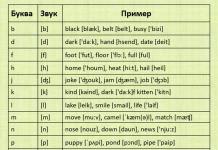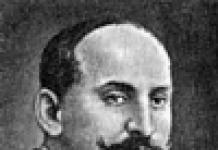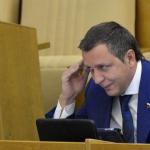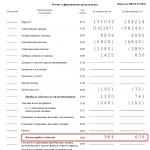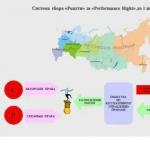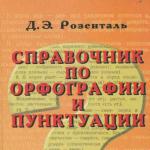Albert Einstein is a legendary physicist, a leading light of science of the 20th century. He owns the creation general relativity And special theory of relativity, as well as a powerful contribution to the development of other areas of physics. It was GTR that formed the basis of modern physics, combining space with time and describing almost all visible cosmological phenomena, including allowing for the possibility of the existence wormholes, black holes, fabrics of space-time, as well as other gravitational-scale phenomena.
The childhood of a brilliant scientist
The future Nobel laureate was born on March 14, 1879 in the German town of Ulm. At first, nothing foreshadowed a great future for the child: the boy began to speak late, and his speech was somewhat slow.

Einstein's first scientific research took place when he was three years old. For his birthday, his parents gave him a compass, which later became his favorite toy. The boy was extremely surprised that the compass needle always pointed to the same point in the room, no matter how it was turned.
Meanwhile, Einstein's parents were concerned about his speech problems. As the scientist’s younger sister Maya Winteler-Einstein said, the boy repeated every phrase he was preparing to utter, even the simplest, to himself for a long time, moving his lips. The habit of speaking slowly later began to irritate Einstein’s teachers. However, despite this, after the first days of studying at a Catholic primary school, he was identified as a capable student and transferred to the second grade. After his family moved to Munich, Einstein began studying at a gymnasium. However, here, instead of studying, he preferred to study his favorite sciences on his own, which yielded results: in the exact sciences, Einstein was far ahead of his peers. At the age of 16 he mastered differential and integral calculus. At the same time, Einstein read a lot and played the violin beautifully. Later, when the scientist was asked what prompted him to create the theory of relativity, he referred to the novels of Fyodor Dostoevsky and the philosophy of Ancient China.
Youth
Without graduating from high school, 16-year-old Albert went to enter a polytechnic school in Zurich, but “failed” the entrance exams in languages, botany and zoology. At the same time, Einstein brilliantly passed mathematics and physics, after which he was immediately invited to the senior class of the cantonal school in Aarau, after which he became a student at the Zurich Polytechnic. The teaching style and methodology at the Polytechnic differed significantly from the ossified and authoritarian German school, so further education was easier for the young man. Here his teacher was a mathematician Herman Minkowski

. They say that it was Minkowski who was responsible for giving the theory of relativity a complete mathematical form. Einstein managed to graduate from the university with a high score and with negative characteristics from the teachers:
At the educational institution, the future Nobel laureate was known as an avid truant. Einstein later said that he “simply did not have time to go to class.”
For a long time the graduate could not find a job. “I was bullied by my professors, who did not like me because of my independence and closed my path to science,” said Einstein.
Beginning of scientific activity and first work In 1901, the Berlin Annals of Physics published his first article."Consequences of the theory of capillarity"
, dedicated to the analysis of the forces of attraction between atoms of liquids based on the theory of capillarity. Former classmate Marcel Grossman helped to overcome difficulties with employment, who recommended Einstein for the position of third-class expert at the Federal Bureau of Patents of Inventions (Bern). Einstein worked at the Patent Office from July 1902 to October 1909, primarily assessing patent applications. In 1903 he became a permanent employee of the Bureau. The nature of the work allowed Einstein to devote his free time to research in the field of theoretical physics.
Personal life Even at university, Einstein was known as a lover of women, but over time he chose, whom he met in Zurich. Mileva was four years older than Einstein, but studied in the same course as him. She studied physics, and she and Einstein were brought together by their interest in the works of great scientists. Einstein needed a friend with whom he could share his thoughts about what he was reading. Mileva was a passive listener, but Einstein was quite satisfied with this. At that time, fate did not pit him against a comrade equal to him in mental strength (this did not fully happen later), nor with a girl whose charm did not need a common scientific platform.

Einstein’s wife “shone in mathematics and physics”: she was excellent at performing algebraic calculations and had a good grasp of analytical mechanics. Thanks to these qualities, Maric could take an active part in the writing of all her husband’s major works. The union of Maric and Einstein was destroyed by the latter's inconstancy. Albert Einstein enjoyed enormous success with women, and his wife was constantly tormented by jealousy. Their son Hans-Albert later wrote: “The mother was a typical Slav with very strong and persistent negative emotions. She never forgave insults..."
For the second time, the scientist married his cousin Elsa. Contemporaries considered her a narrow-minded woman, whose range of interests was limited to clothes, jewelry and sweets.

Successful 1905
The year 1905 went down in the history of physics as the “Year of Miracles.” This year, the Annals of Physics published three outstanding papers by Einstein that marked the beginning of a new scientific revolution:
- "On the electrodynamics of moving bodies"(the theory of relativity begins with this article).
- “On one heuristic point of view concerning the origin and transformation of light”(one of the works that laid the foundation for quantum theory).
- “On the motion of particles suspended in a fluid at rest, required by the molecular kinetic theory of heat”(work dedicated to Brownian motion and significantly advanced statistical physics).
It was these works that brought Einstein worldwide fame. On April 30, 1905, he sent the text of his doctoral dissertation on the topic “A New Determination of the Size of Molecules” to the University of Zurich. Although Einstein’s letters are already called “Mr. Professor,” he remained for four more years (until October 1909). And in 1906 he even became a class II expert.
In October 1908, Einstein was invited to read an elective course at the University of Bern, however, without any payment. In 1909, he attended a congress of naturalists in Salzburg, where the elite of German physics gathered, and met Planck for the first time; over 3 years of correspondence they quickly became close friends.

After the convention, Einstein finally received a paid position as extraordinary professor at the University of Zurich (December 1909), where his old friend Marcel Grossmann taught geometry. The pay was small, especially for a family with two children, and in 1911 Einstein without hesitation accepted an invitation to head the department of physics at the German University in Prague. During this period, Einstein continued to publish a series of papers on thermodynamics, relativity and quantum theory. In Prague, he intensifies research on the theory of gravity, setting the goal of creating a relativistic theory of gravity and fulfilling the long-standing dream of physicists - to exclude Newtonian long-range action from this area.
Active period of scientific work
In 1912, Einstein returned to Zurich, where he became a professor at his native Polytechnic and lectured there on physics. In 1913, he attended the Congress of Naturalists in Vienna, visiting 75-year-old Ernst Mach there; Once upon a time, Mach's criticism of Newtonian mechanics made a huge impression on Einstein and ideologically prepared him for the innovations of the theory of relativity. In May 1914, an invitation came from the St. Petersburg Academy of Sciences, signed by physicist P. P. Lazarev. However, the impressions of the pogroms and the “Beilis case” were still fresh, and Einstein refused: “I find it disgusting to go unnecessarily to a country where my fellow tribesmen are so cruelly persecuted.”
At the end of 1913, on the recommendation of Planck and Nernst, Einstein received an invitation to head the physics research institute being created in Berlin; He is also enrolled as a professor at the University of Berlin. In addition to being close to his friend Planck, this position had the advantage that it did not require him to be distracted by teaching. He accepted the invitation, and in the pre-war year 1914, the convinced pacifist Einstein arrived in Berlin. Citizenship of Switzerland, a neutral country, helped Einstein withstand militaristic pressure after the outbreak of war. He did not sign any “patriotic” appeals; on the contrary, in collaboration with the physiologist Georg Friedrich Nicolai, he compiled the anti-war “Appeal to the Europeans” in contrast to the chauvinistic manifesto of the 1993s, and in a letter to Romain Rolland wrote: “Will future generations thank our Europe, in which three centuries of the most intense cultural work only led to the fact that religious madness was replaced by nationalistic madness? Even scientists from different countries behave as if their brains were amputated.”
Main work
Einstein completed his masterpiece, the general theory of relativity, in 1915 in Berlin. It presented a completely new idea of space and time. Among other phenomena, the work predicted the deflection of light rays in a gravitational field, which was subsequently confirmed by English scientists.
But Einstein received the Nobel Prize in Physics in 1922 not for his ingenious theory, but for his explanation of the photoelectric effect (the knocking out of electrons from certain substances under the influence of light). In just one night, the scientist became famous throughout the world.
This is interesting! The scientist's correspondence, released three years ago, says that Einstein invested most of the Nobel Prize in the United States, losing almost everything due to the Great Depression.
Despite the recognition, in Germany the scientist was constantly persecuted, not only because of his nationality, but also because of his anti-militarist views. “My pacifism is an instinctive feeling that controls me because killing a person is disgusting. My attitude does not come from any speculative theory, but is based on the deepest antipathy to any kind of cruelty and hatred,” the scientist wrote in support of his anti-war position. At the end of 1922, Einstein left Germany and went on a trip. And once in Palestine, he solemnly opens the Hebrew University in Jerusalem.
More about the main scientific prize (1922)
In fact, Einstein’s first marriage broke up in 1914; in 1919, during the legal divorce proceedings, the following written promise from Einstein appeared: “I promise you that when I receive the Nobel Prize, I will give you all the money. You must agree to the divorce, otherwise you will get nothing at all." The couple were confident that Albert would become a Nobel laureate for the theory of relativity. He actually received the Nobel Prize in 1922, although with a completely different wording (for explaining the laws of the photoelectric effect). Since Einstein was away, the prize was accepted on his behalf on December 10, 1922 by Rudolf Nadolny, the German Ambassador to Sweden. Previously, he asked for confirmation whether Einstein was a citizen of Germany or Switzerland; The Prussian Academy of Sciences has officially certified that Einstein is a German subject, although his Swiss citizenship is also recognized as valid. Upon his return to Berlin, Einstein received the insignia accompanying the prize personally from the Swedish ambassador. Naturally, Einstein dedicated his traditional Nobel speech (in July 1923) to the theory of relativity. By the way, Einstein kept his word: he gave all 32 thousand dollars (the amount of the bonus) to his ex-wife.
1923–1933 in the life of Einstein
In 1923, completing his journey, Einstein spoke in Jerusalem, where it was planned to open the Hebrew University soon (1925).
As a person of enormous and universal authority, Einstein was constantly involved in various kinds of political actions during these years, where he advocated social justice, internationalism and cooperation between countries (see below). In 1923, Einstein participated in the organization of the cultural relations society “Friends of the New Russia”. He repeatedly called for the disarmament and unification of Europe, and for the abolition of compulsory military service. Until about 1926, Einstein worked in many areas of physics, from cosmological models to research into the causes of river meanders. Further, with rare exceptions, he focuses his efforts on quantum problems and the Unified Field Theory.

In 1928, Einstein saw off Lorentz, with whom he became very friendly in his last years, on his last journey. It was Lorentz who nominated Einstein for the Nobel Prize in 1920 and supported it the following year. In 1929, the world noisily celebrated Einstein's 50th birthday. The hero of the day did not take part in the celebrations and hid in his villa near Potsdam, where he enthusiastically grew roses. Here he received friends - scientists, Tagore, Emmanuel Lasker, Charlie Chaplin and others. In 1931, Einstein visited the USA again. In Pasadena he was very warmly received by Michelson, who had four months to live. Returning to Berlin in the summer, Einstein, in a speech to the Physical Society, paid tribute to the memory of the remarkable experimenter who laid the first stone of the foundation of the theory of relativity.
Years in exile
Albert Einstein did not hesitate to accept the offer to move to Berlin. But the opportunity to communicate with major German scientists, including Planck, attracted him. The political and moral atmosphere in Germany became more and more oppressive, anti-Semitism was raising its head, and when the Nazis seized power, Einstein left Germany forever in 1933. Subsequently, as a sign of protest against fascism, he renounced German citizenship and resigned from the Prussian and Bavarian Academies of Sciences.
During the Berlin period, in addition to the general theory of relativity, Einstein developed the statistics of particles of integer spin, introduced the concept of stimulated radiation, which plays an important role in laser physics, predicted (together with de Haas) the phenomenon of the emergence of a rotational momentum of bodies when they are magnetized, etc. However, being One of the creators of quantum theory, Einstein did not accept the probabilistic interpretation of quantum mechanics, believing that a fundamental physical theory cannot be statistical in nature. He often repeated that "God doesn't play dice with the universe".
Having moved to the United States, Albert Einstein took a position as professor of physics at the new Institute for Basic Research in Princeton (New Jersey). He continued to study issues of cosmology, and also intensively searched for ways to build a unified field theory that would unify gravity, electromagnetism (and possibly the rest). And although he failed to implement this program, this did not shake Einstein’s reputation as one of the greatest natural scientists of all time.
Atomic bomb

In the minds of many people, Einstein's name is associated with the atomic problem. Indeed, realizing what a tragedy for humanity the creation of an atomic bomb in Nazi Germany could be, in 1939 he sent a letter to the President of the United States, which served as an impetus for work in this direction in America. But already at the end of the war, his desperate attempts to keep politicians and generals from criminal and insane actions were in vain. This was the biggest tragedy of his life. On August 2, 1939, Einstein, who was living in New York at the time, wrote a letter to Franklin Roosevelt to prevent the Third Reich from acquiring atomic weapons. In the letter, he called on the American president to work on his own atomic weapons.
On the advice of physicists, Roosevelt organized the Uranium Advisory Committee, but found little interest in the problem of developing nuclear weapons. He believed that the likelihood of its creation was low. The situation changed two years later, when physicists Otto Frisch and Rudolf Pierls discovered that a nuclear bomb could actually be made and that it was large enough to be transported by a bomber. During the war, Einstein advised the US Navy and contributed to solving various technical problems.
Post-war years
At this time, Einstein became one of the founders Pugwash Peace Scientists Movement. Although its first conference was held after Einstein’s death (1957), the initiative to create such a movement was expressed in the widely known Russell-Einstein Manifesto (written jointly with Bertrand Russell), which also warned about the dangers of the creation and use of the hydrogen bomb. As part of this movement, Einstein, who was its chairman, together with Albert Schweitzer, Bertrand Russell, Frederic Joliot-Curie and other world-famous scientists, fought against the arms race and the creation of nuclear and thermonuclear weapons.
In September 1947, in an open letter to delegations of UN member states, he proposed to reorganize the UN General Assembly, turning it into a permanent world parliament, with greater powers than the Security Council, which (in Einstein's opinion) was paralyzed in its actions by law veto. To which in November 1947, the largest Soviet scientists (S.I. Vavilov, A.F. Ioffe, N.N. Semenov, A.N. Frumkin) expressed disagreement with the position of A. Einstein (1947) in an open letter.
Last years of life. Death
Death overtook the genius at Princeton Hospital (USA) in 1955. The autopsy was performed by a pathologist named Thomas Harvey. He extracted Einstein's brain for study, but instead of making it available to science, he took it for himself. Risking his reputation and job, Thomas placed the brain of the greatest genius in a jar of formaldehyde and took it to his home. He was convinced that such action was a scientific duty for him. Moreover, Thomas Harvey sent pieces of Einstein’s brain for research to leading neurologists for 40 years. The descendants of Thomas Harvey tried to return to Einstein’s daughter what was left of her father’s brain, but she refused such a “gift”. From then to this day, the remains of the brain, ironically, are in Princeton, from where it was stolen.
Scientists who examined Einstein's brain proved that the gray matter was different from normal. Scientific studies have shown that the areas of Einstein's brain responsible for speech and language are reduced, while the areas responsible for processing numerical and spatial information are enlarged. Other studies have found an increase in the number of neuroglial cells (cells of the nervous system that make up half the volume of the central nervous system. Neurons of the central nervous system are surrounded by glial cells).
Einstein was a heavy smoker

More than anything in the world, Einstein loved his violin and pipe. A heavy smoker, he once said that he believed smoking was necessary for peace and "objective judgement" in people. When his doctor prescribed him to quit his bad habit, Einstein put his pipe in his mouth and lit a cigarette. Sometimes he would also pick up cigarette butts on the streets to light in his pipe.
Einstein received life membership in the Montreal Pipe Smoking Club. One day he fell overboard during a boat trip, but managed to save his treasured pipe from the water. Apart from his many manuscripts and letters, the pipe remains one of the few personal items we have of Einstein.
Einstein often kept to himself
To be independent of conventional wisdom, Einstein often isolated himself in solitude. This was a childhood habit. He even started talking at the age of 7 because he did not want to communicate. He built cozy worlds and contrasted them with reality. The world of family, the world of like-minded people, the world of the patent office where I worked, the temple of science. “If the sewage of life licks the steps of your temple, close the door and laugh... Do not give in to anger, remain as before as a saint in the temple.” He followed this advice.
Impact on culture
Albert Einstein has become the hero of a number of fictional novels, films and theatrical productions. In particular, he appears as an actor in the film by Nicholas Rog "Insignificance", the comedy by Fred Schepisi "I.Q.", the film by Philip Martin "Einstein and Eddington" (2008), in the Soviet / Russian films "Choice of Target", "Wolf Messing", a comic play by Steve Martin, the novels "Please, Monsieur Einstein" by Jean-Claude Carrier and "Einstein's Dreams" by Alan Lightman, the poem "Einstein" by Archibald MacLeish. The humorous component of the great physicist's personality appears in Ed Metzger's production of Albert Einstein: Practical Bohemian. “Professor Einstein,” who creates the chronosphere and prevents Hitler from coming to power, is one of the key characters in the alternative Universe he created in the Command & Conquer series of real-time computer strategies. The scientist in the film "Cain XVIII" is clearly made up to look like Einstein.
The appearance of Albert Einstein, usually seen as an adult in a simple sweater with disheveled hair, has become a staple in popular culture's portrayal of "mad scientists" and "absent-minded professors." In addition, it actively exploits the motif of the great physicist’s forgetfulness and impracticality, which is transferred to the collective image of his colleagues. Time magazine even called Einstein "a cartoonist's dream come true." Albert Einstein's photographs have become widely known. The most famous one was made at the physicist’s 72nd birthday (1951).

Photographer Arthur Sass asked Einstein to smile for the camera, to which he stuck out his tongue. This image has become an icon of modern popular culture, presenting a portrait of both a genius and a cheerful living person. On June 21, 2009, at an auction in New Hampshire, America, one of the nine original photographs printed in 1951 was sold for $74,000. A. Einstein gave this photograph to his friend, journalist Howard Smith, and signed on it that “the humorous grimace is addressed to all humanity”.
Einstein’s popularity in the modern world is so great that controversial issues arise in the widespread use of the scientist’s name and appearance in advertising and trademarks. Because Einstein bequeathed some of his property, including the use of his images, to the Hebrew University of Jerusalem, the brand "Albert Einstein" was registered as a trademark.
Sources
- http://to-name.ru/biography/albert-ejnshtejn.htm http://www.aif.ru/dontknows/file/kakim_byl_albert_eynshteyn_15_faktov_iz_zhizni_velikogo_geniya
V. Ya. Frenkel, B. E. Yavelov
Magnetostrictive loudspeaker
On January 10, 1934, the German Patent Office, based on an application filed on April 25, 1929, issued patent No. 590783 for “A device, in particular for a sound reproduction system, in which changes in electric current due to magnetostriction cause the movement of a magnetic body.” One of the two authors of the invention was listed as Dr. Rudolf Goldschmidt from Berlin, and the other was written as follows: “Dr. Albert Einstein, formerly residing in Berlin; present residence unknown.”
Magnetostriction, as is known, is the effect of reducing the size of magnetic bodies (usually referring to ferromagnets) when they are magnetized. In the preamble to the patent description, the inventors write that the magnetic compression forces are hampered by the rigidity of the ferromagnet. In order to “make magnetostriction work” (in this case, to set the speaker cone into oscillatory motion), this rigidity must be somehow neutralized and compensated. Einstein and Goldschmidt offer three options for this seemingly intractable problem.
Rice. Three magpitostrictive loudspeaker options
The first option is illustrated in Fig. a. The ferromagnetic (iron) rod B carrying the needle C with the diffuser is screwed into a strong U-shaped magnetic yoke A in such a way that the axial forces compressing the rod are very close to the critical value at which Euler loss of stability occurs - bending of the rod in one direction or another. Windings D are placed on the yoke, through which an electric current passes, modulated by an audio signal. Thus, the stronger the sound, the more strongly the iron rod B is magnetized and, consequently, compressed. Since the rod is placed on the very verge of instability, these small variations in its length lead to strong vibrations in the vertical direction; in this case, a diffuser attached to the middle of the rod generates sound.
The second option (Fig. b) uses the instability of the compressed spring H - rod G system, resting its tip against the hole S. A current modulated by an audio signal passes through the winding D. The time-varying magnetization of the iron rod leads to small fluctuations in its length, which are amplified due to energy of a powerful spring losing stability.
In the third version of the magnetostrictive loudspeaker (Fig. c), a circuit is used with two iron rods B1 and B2, the windings of which are connected in such a way that when the magnetization of one rod increases, the magnetization of the other decreases. By means of rods C1 and C2, the rods are connected to a rocker arm G, suspended on a rod M and attached by guy wires F to the sides of the magnetic yoke A. The rocker arm is rigidly connected to the diffuser W. By screwing the nut P on the rod M, the system is transferred to a state of unstable equilibrium. Due to the antiphase magnetization of rods B1 and B2 with an audio frequency current, their deformations also occur in antiphase - one is compressed, the other is lengthened (the compression is weakened), and the rocker, in accordance with the sound signal, warps, turning relative to point R. In this case, also due to the use of a “hidden "instability, the amplitude of magnetostrictive oscillations increases.
X. Melcher, who got acquainted with the documents of the family of R. Goldschmidt and talked with his son, sets out the history of the appearance of this invention as follows.
R. Goldschmidt (1876-1950) was a good friend of Einstein. A well-known specialist in the field of electrical engineering, at the dawn of the radio era he supervised the installation of the first line of wireless telegraph communication between Europe and America (1914). In 1910, he designed and built the world's first high-frequency machine at 30 kHz with a power of 12 kW, suitable for radio engineering purposes. The machine for transatlantic transmissions already had a power of 150 kW. Goldschmidt was also the author of many inventions aimed at improving sound-reproducing devices (mainly for telephones), high-frequency resonators, etc.
Mutual friends of Einstein and Goldschmidt were the spouses Olga and Bruno Eisner, a famous singer and a famous pianist at that time. Olga Aizner was hard of hearing - a disadvantage that was especially annoying considering her profession. Goldschmidt, as a specialist in sound-reproducing equipment, undertook to help her. He decided to design a hearing aid (work on the creation of such devices was just beginning at that time). Einstein also took part in this activity.
Whether a functioning hearing aid was eventually constructed is unknown. As can be seen from the patent description, the inventors were fascinated by the idea of using the previously unused magnetostriction effect, and they developed the loudspeakers we described based on this effect. As far as we know, this was the first sound-reproducing magnetostrictive device. Although magnetostrictive hearing aids have not become widespread and their current counterparts operate on different principles, magnetostriction is used with great success in ultrasonic emitters, which are used in many branches of industry and technology.
For Frau Olga, as Melcher reports, they planned to create a magnetostrictive hearing aid using the phenomenon of so-called bone conduction, i.e. exciting sound vibrations not of the air column in the ear, but directly of the cranial bones, which required great power. It seems that the Einstein-Goldschmidt device fully met this requirement. Perhaps the joint activity with Goldschmidt was not so accidental and, in doing it, Einstein was guided not only by the desire to ease the fate of Frau Eisner. It seems that he could not help but be interested in the technical task itself - after all, we know that he had some experience in designing sound-reproducing devices.
Automatic camera
Talking with Rabindranath Tagore in the early 30s, Einstein recalled his “happy Bern years” and said that, while working in the patent office, he invented several technical devices, including a sensitive electrometer (already discussed above) and a device determining the exposure time when taking photographs. Now such a device is called a photo exposure meter.
There is almost no doubt that the operating principle of Einstein's photoexposure meter was based on the photoelectric effect. And who knows, maybe this invention was a by-product of reflections that culminated in the famous 1905 article “On a Heuristic Point of View...”, in which the idea of light quanta was introduced and, with their help, the laws of the photoelectric effect were explained.
It is curious that Einstein retained his interest in devices of this kind for a long time, although, as far as is known, he was never an amateur photographer. Thus, his authoritative biographer F. Frank reports that somewhere in the second half of the 40s, Einstein and one of his closest friends, MD G. Bucchi, “invented a mechanism for automatically adjusting exposure time depending on illumination”)

